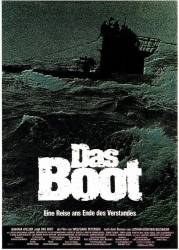Question: During the film one of the officers was holding a bottle of Becks beer. Was the label on the bottle age/era appropriate?
Question: What's the music the German band are playing at the end when U96 returns to port?
Answer: It's the 'Erzherzog Albrecht Marsch', composed 1887.
Question: The enemy is referred to as "tommies". Why do they call them that?
Answer: Tommy or Tommy Atkins is a term for a common soldier in the British Army. It is particularly associated with being used by the Germans during WWI, but may have been around as early as 1743 - see: http://en.wikipedia.org/wiki/Tommies.
Question: When the U-Boat leaves La Rochelle the Kriegsmarine brass band plays "Muss I' Denn, Muss I' Denn", an old German love song that many people will recognise from an Elvis Presley movie, GI Blue I think,with the title "Wooden Heart". But when the boat returns the band plays a much more martial march (which does not prevent a soldier on the pier from dancing!). But which marching tune?
Answer: The music the band plays at the end of the film is the Erzherzog-Albrecht-Marsch. In the uncut edition (which features a longer departure), the march is also played.
Question: They're nearly sunk and killed when trying to get through Gibraltar, but through some miracle they make it anyway. Then suddenly they're heading back to La Rochelle. If it was so impossible to get in to the Mediterranean, how come it was so easy to get out?
Answer: We don't actually know that it was particularly easy for them to get out - it may have been quite a tense situation, but, from the cinematic point of view, that situation has already been shown once; repeating it would be an unnecessary duplication and would take time that could be better used on showing other events. All we need to know is that they made it through a second time - the precise details aren't that important to the overall storyline.
Question: They're nearly sunk and killed when trying to get through Gibraltar, but through some miracle they make it anyway. Then suddenly they're heading back to La Rochelle. If it was so impossible to get in to the Mediterranean, how come it was so easy to get out?
Answer: They don't make it into the Mediterranean, but sit on the bottom for a long time. The depth of the Straits is about 300m which is 100m deeper than the submarine was rated for. Getting through the Straits was a death trap for German submarines because the Straits of Gibraltar are only about 14km at their narrowest point. Also the Med was dangerous for subs as the waters of the Med are quite clear and even submerged submarines can be spotted from the air. This is why the crew was dismayed to learn they were to go to the Med.
Question: I know practically nothing about submarines, so this seemed a bit strange to me. When there's that huge storm, why do they keep staying at the surface, only going down for an hour at a time?
Answer: U-boats also travelled much faster on the surface...about 18 knots, vs only 8 knots or so beneath the surface.
Answer: Because that's what the U-boat was designed to do. Unlike modern nuclear boats, they didn't have the capacity to stay submerged for long periods - basically just as long as the air lasted; there wasn't atmosphere control equipment. They would 'snorkel' near the surface, recharge the batteries with the diesel engines, and then dive for a few hours at most before having to come back up and repeat the process.
Question: When the U-boat is at 200 meters depth, and even deeper, it is attacked with depth charges. We can see the charges explode close to the hull. Was it really possible to set charges to explode at this depth? In 1943 the US developed depth charges that could be set to 180 meters.
Answer: The Royal Navy Depth Charge Mark VII could be detonated as deep as 270 meters, this is after 1940 but before 1943. This is below the crushing depth of the Type viic U-boat from the movie.






Answer: The label is absolutely correct, but at this time Beck's Beer was only for export and not regularly available in Germany.